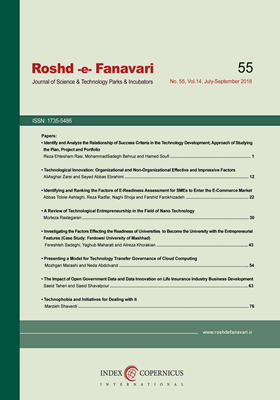-
-
List of Articles
-
Open Access Article
1 - Presenting a Model for Technology Transfer Governance of Cloud Computing
mozhgan marashi neda abdolvand -
Open Access Article
2 - A Review of Technological Entrepreneurship in the Field of Nano Technology
Morteza Rastegaran -
Open Access Article
3 - Identifying and Ranking the Factors of E-Readiness Assessment for SMEs to Enter the E-Commerce Market
Abbas Toloie Eshlaghy Farshid Farokhizadeh Reza Radfar Naghi Shoja -
Open Access Article
4 - Identify and Analyze the Relationship of Success Criteria in the Technology Development; Approach of Studying the Plan, Project and Portfolio
Reza Ehteshamrasi MohammadSadeq Behrouz Hamed Sufi -
Open Access Article
5 - Technophobia and Initiatives for Dealing with it
Marziyah Sahverdi -
Open Access Article
6 - Technological Innovation: Organizational and Non-Organizational Effective and Impressive Factors
ali asghar zarei seyed abbas ebrahimi -
Open Access Article
7 - Investigating the Factors Effecting the Readiness of Universities to Become the University with the Entrepreneurial Features (Case Study: Ferdowsi University of Mashhad)
fereshte sadeghi yaghoob maharati alireza khorakian -
Open Access Article
8 - The Impact of Open Government Data and Data Innovation on Life Insurance Industry Business Development
Saeid Taheri Saeed Shavalpour
-
The rights to this website are owned by the Raimag Press Management System.
Copyright © 2017-2025







